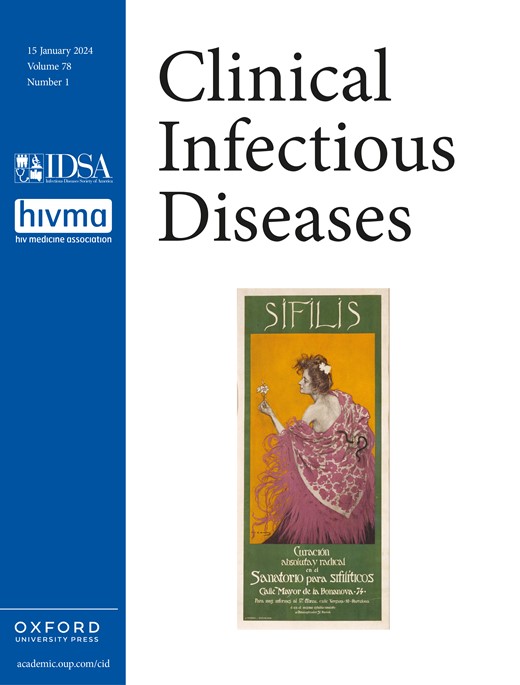Real-Time Genomic Surveillance for Enhanced Healthcare Outbreak Detection and Control: Clinical and Economic Impact.
IF 8.2
1区 医学
Q1 IMMUNOLOGY
引用次数: 0
Abstract
BACKGROUND Current methods are insufficient alone for outbreak detection in hospitals. Real-time genomic surveillance offers the potential to detect otherwise unidentified outbreaks. We initiated and evaluated the Enhanced Detection System for Healthcare-associated Transmission (EDS-HAT), a real-time genomic surveillance program for outbreak detection and mitigation. METHODS This study was conducted at UPMC Presbyterian Hospital from November 2021 to October 2023. Whole genome sequencing (WGS) was performed weekly on healthcare-associated clinical bacterial isolates to identify otherwise undetected outbreaks. IP&C interventions were implemented in real-time based on identified transmission. A clinical and economic impact analysis was conducted to estimate infections avoided and net cost savings. RESULTS There were 3,921 bacterial isolates from patient healthcare-associated infections that underwent WGS, of which 476 (12.1%) clustered into 172 outbreaks (size 2-16 patients). Of the outbreak isolates, 292 (61.3%) had an identified epidemiological link. Among the outbreaks with interventions, 95.6% showed no further transmission on the intervened transmission route. The impact analysis estimated that, over the two-year period, 62 infections and 4.8 deaths were avoided, with gross cost savings of $1,011,146, and net savings of $695,706, which translates to a 3.2-fold return on investment. Probabilistic sensitivity analysis showed EDS-HAT was cost-saving and more effective in 98% of simulations. CONCLUSION Real-time genomic surveillance enabled the rapid detection and control of outbreaks in our hospital and resulted in patient and economic benefits. This study demonstrates the feasibility and effectiveness of integrating genomic surveillance into routine infection prevention practice, offering a paradigm shift in healthcare outbreak detection and control.实时基因组监测增强医疗爆发检测和控制:临床和经济影响。
背景:目前的方法不足以单独在医院进行疫情检测。实时基因组监测提供了发现其他未查明疫情的潜力。我们启动并评估了医疗保健相关传播增强检测系统(EDS-HAT),这是一个用于疾病爆发检测和缓解的实时基因组监测项目。方法本研究于2021年11月至2023年10月在UPMC长老会医院进行。每周对卫生保健相关的临床细菌分离株进行全基因组测序(WGS),以确定其他未被发现的暴发。根据已查明的传播情况,实时实施IP&C干预措施。进行了临床和经济影响分析,以估计避免的感染和净成本节约。结果共分离出3921株WGS患者卫生保健相关感染的细菌,其中476株(12.1%)聚集在172次暴发中(规模2-16例患者)。在暴发分离株中,有292株(61.3%)具有确定的流行病学联系。在采取干预措施的疫情中,95.6%的疫情未通过干预传播途径进一步传播。影响分析估计,在这两年期间,避免了62例感染和4.8例死亡,总费用节省1 011,146美元,净节省695 706美元,相当于投资回报达到3.2倍。概率敏感性分析表明,EDS-HAT在98%的模拟中节省了成本,并且更有效。结论实时基因组监测能够快速发现和控制我院的疫情,为患者和经济带来效益。本研究证明了将基因组监测整合到常规感染预防实践中的可行性和有效性,为卫生保健暴发检测和控制提供了范式转变。
本文章由计算机程序翻译,如有差异,请以英文原文为准。
求助全文
约1分钟内获得全文
求助全文
来源期刊

Clinical Infectious Diseases
医学-传染病学
CiteScore
25.00
自引率
2.50%
发文量
900
审稿时长
3 months
期刊介绍:
Clinical Infectious Diseases (CID) is dedicated to publishing original research, reviews, guidelines, and perspectives with the potential to reshape clinical practice, providing clinicians with valuable insights for patient care. CID comprehensively addresses the clinical presentation, diagnosis, treatment, and prevention of a wide spectrum of infectious diseases. The journal places a high priority on the assessment of current and innovative treatments, microbiology, immunology, and policies, ensuring relevance to patient care in its commitment to advancing the field of infectious diseases.
 求助内容:
求助内容: 应助结果提醒方式:
应助结果提醒方式:


